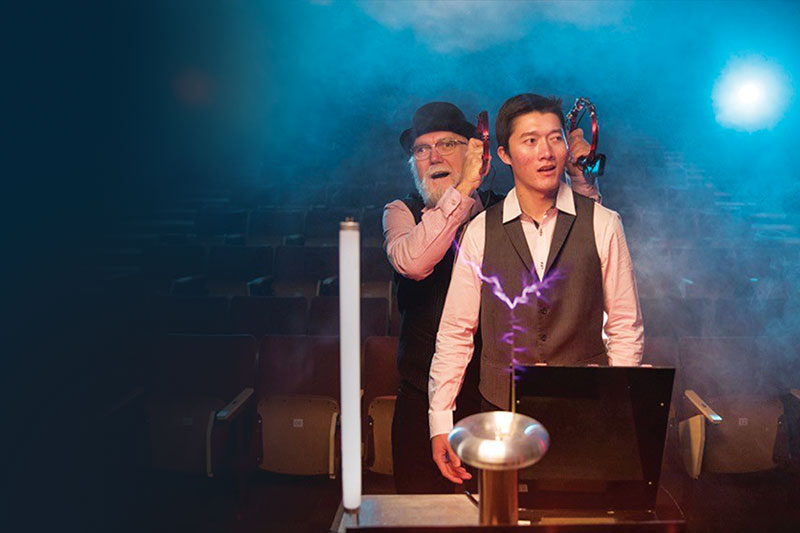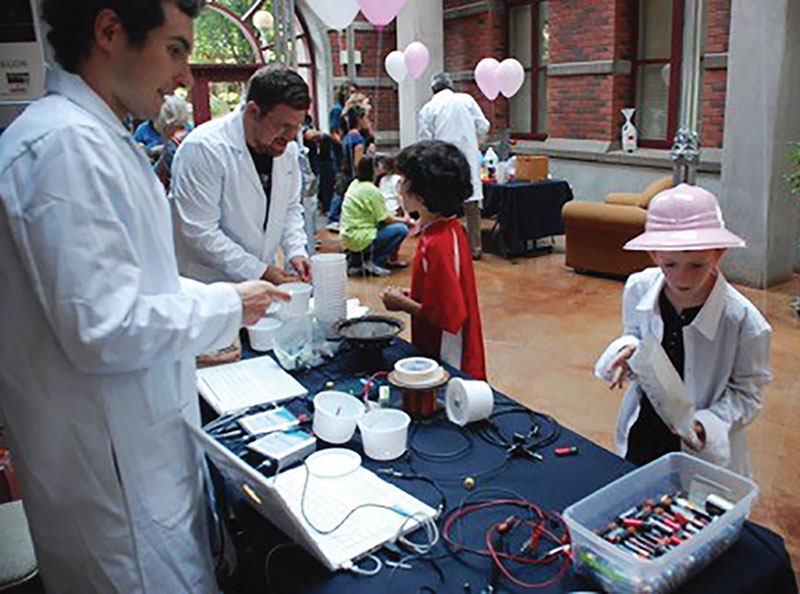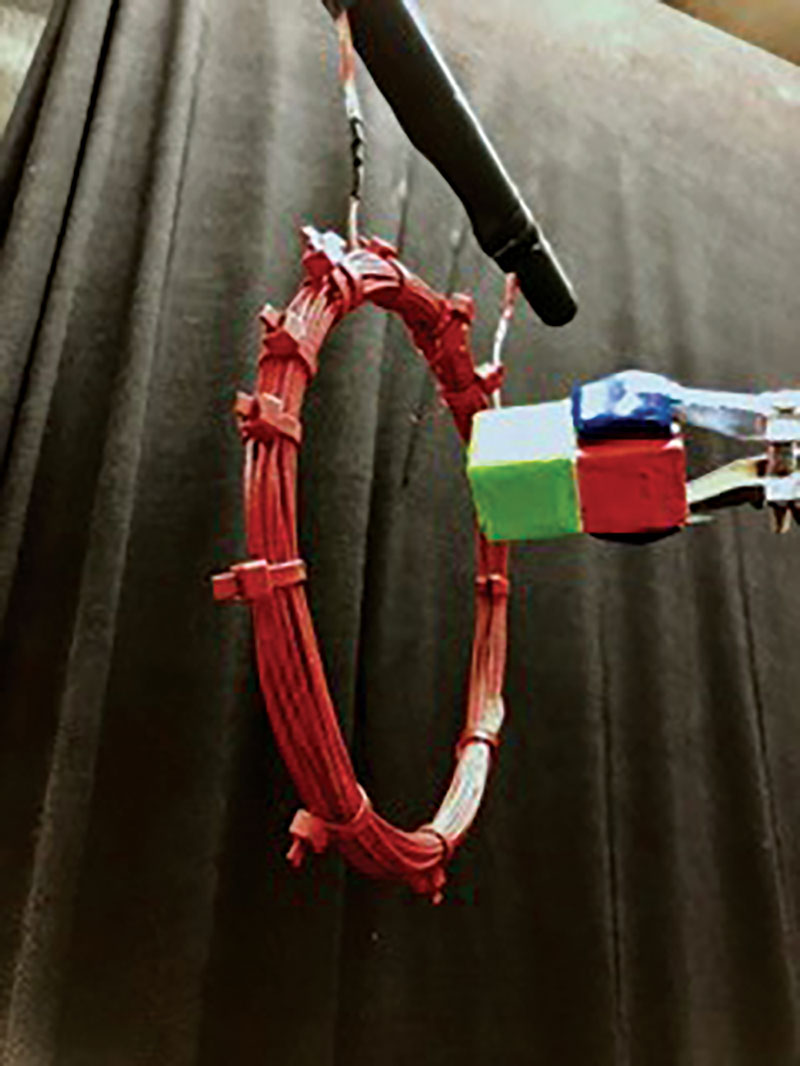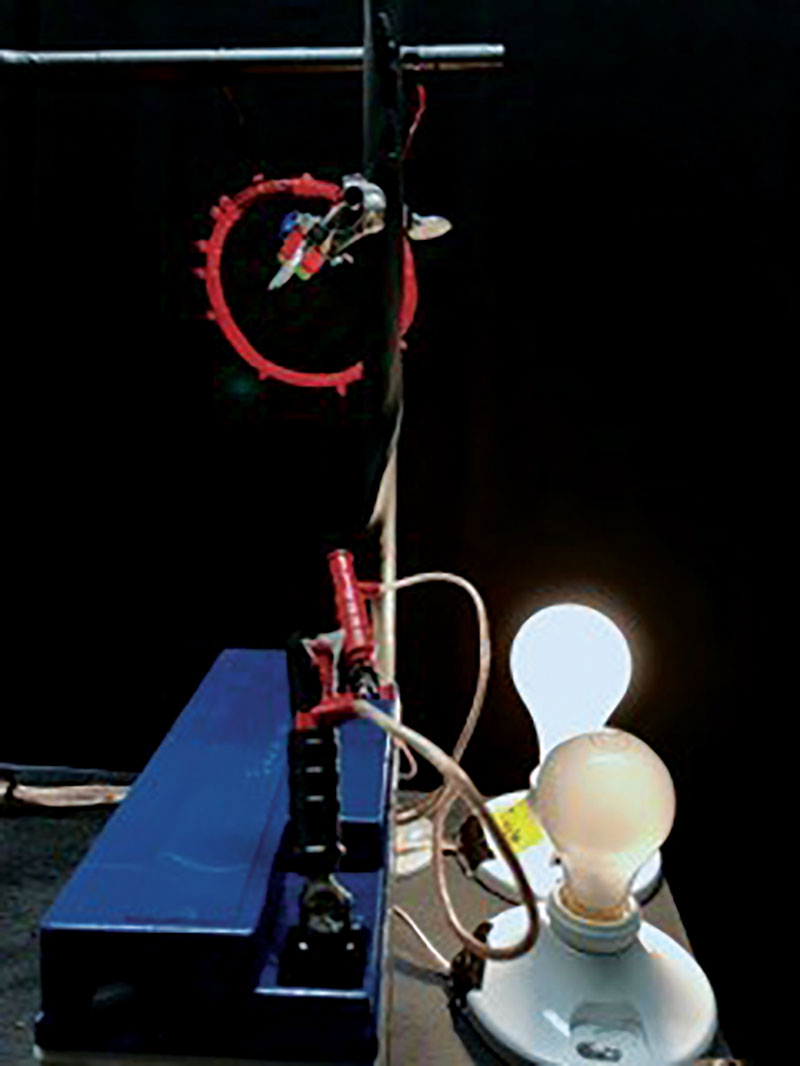Science Communication and Outreach
Spring
2018
Feature
Science Communication and Outreach
Stanley Micklavzina, Department of Physics, University of Oregon
Outreach inspires scientific literacy while promoting public understanding of the benefits of physics education and research. Community and educational partnerships also foster curiosity and passion in the next generation. These activities enrich the experience of the participating undergraduate students as ambassadors of science by promoting a deeper commitment to their discipline. – SPS National Council outreach statement, adopted 2013

Science outreach is a form of science communication that serves to:
- inspire young minds in schools and public venues,
- communicate to the public an understanding of the importance of science education and research,
- promote the science program offered at a college or university,
- and deepen the understanding of the presented science for the presenter.
While outreach and demonstrations can be challenging to make work in front of an audience, it’s one of the most important things you can do for both the audience and yourself. You are able to hone your knowledge of physics, practice presentation skills, field (sometimes difficult) questions you might have never thought of, and support the next generation of physicists and astronomers. A win for all involved!
Before you begin, consider the following steps to make sure you make the impact you are hoping for:
- Identify your audience.
- Determine the goal of the event.
- Select the physics concepts you want the audience to consider.
- Don’t rush through the presentation, as thinking takes time.
- Repeat the important concepts multiple times, but in different ways.
- Relate the physics principles to their daily lives.
- Locate volunteers, identify the right venue, and double– check your setup.
I classify three primary ways to facilitate outreach to the community. Each method has different goals and outcomes, so think about what resources you have available and what outcomes you are looking for.
1. The Stage
My personal preference is to focus on an interesting and entertaining theme, keeping the presentation from being scattered. The idea is to capture the audience's interest by enhancing demonstrations with descriptions that stimulate and broaden understanding of the science or concepts. Usually, I pick a theme, build up the demonstrations around it, and end with an exciting grand finale. For example, the Physics of Rock 'n Roll show is a string of electricity and magnetism (E&M) demonstrations which build up to show how speakers, microphones, and guitar pickups work. By adding in light, an E&M wave, with a fog machine, the grand finale is a Rock 'n Roll laser light show! Ideally, the demonstrations keep the younger audience captivated while the explanations engage the older students and parents.
Audience participation also enhances the show experience. Keeping the show moving along and well timed is extremely important. All the demonstrations should be laid out in advance, and train volunteers to help with the setup and show presentation. Have an outline of the demonstration order, including lighting or sound cues, for all the stage volunteers. Putting the actual order number on the demonstrations can also help the show run more smoothly, cutting the time you spend looking for parts on a demonstration table.
Suggestions for a stage-type presentation:
- If possible, investigate where you will be doing the presentation. Can lights be dimmed? Is there a sound system? How large is the venue?
- The demonstrations should be visible and organized and practiced well beforehand. Rehearsals are very important! Practice packing and setting up before and after a full rehearsal so you will not forget anything.
- Try to out-think Murphy's law!
- During a presentation, if something goes wrong, make it part of the show. State what is wrong and what you are doing to fix it, or what went wrong and why it went wrong. The physics is always there, and it actually always works!
- Have fun and engage with the audience.

2. Physics and Performance
Physics and Performance has been a project I have been involved with over the years, developing a performance where the people come to be entertained while science is presented at various points within the show. The idea is to provide inspiration and science awareness to a set of people who might not usually attend a science presentation. Recently, I participated in a coordinated interdisciplinary production called "Tesla: Sound, Light, Color" where a tribute to Nikola Tesla involved ballet dancers, an original music score, a string octet, a 50-foot screen displaying computer graphics, and three segments of physics demonstrations showing the principles of E&M, as well as demonstrating a few of Tesla’s inventions. Below is a list of demonstrations used for the performance to help guide you on how to develop a theme of your own.
Electricity: 600BC to 1860
- Electrostatic – Separate charges, repelling and attracting straws by rubbing with different materials
- Separating charges and creating sparks, Van de Graaff
- Battery – Chemicals separate charges using a hand battery
- Light a light bulb by connecting to a 12 V battery – Takes two wires to complete a circuit
- Repeat light connecting 12 V battery – Hanging coil near a strong magnet moves, electricity creates magnetism
- 1820 – Currents light things up but also create a magnetic field, Oersted discovery
- Coil repels or attracts magnet depending on current direction
- DC motor – Switch polarity and make the coil go back and forth
Can Magnets Create Electricity?
- Moving magnet in a coil lights an LED
- 1860 – James Clerk Maxwell publishes his mathematical theory of electromagnetic fields
- 1856 – Nicola Tesla is born, myth has it, at midnight during a lightning storm!
Alternating Current
- AC motor – Hanging coil and bulb with AC/DC current, pendulum
- Resonance – Maximum energy transfer
- Tesla – Transfer energy without wires!
- Small Tesla coil and fluorescent bulb
- Large Tesla coil lights neon signs and fluorescent tubes nearby
Communication: Transfer of Information Without Wires
- Wireless communication transmitter and receiver – Amplifier output to coil with a pickup coil connected to sound system
- Radio signals – Turn on a portable radio
- Tesla coil can make sound, or play music, acting like a speaker with current disturbing the air
3. School or Science Center Activity Visit
This can be an assembly type of presentation, much like the stage, or visiting a particular grade or after-school program. We have visited grade schools with physics students where each student presents an interactive demonstration. The impact of college students interacting with the younger kids is very dramatic, better than the teacher or myself doing it! Young kids will relate more to you, seeing you as an older sibling explaining science rather than another older teacher! I suggest focusing the presentation around a narrow topic or technology: light and color, electricity, solar PV cells, sound and music, astronomy, or pressure and force. Be sure to have notes and a guide to maintain focus while the fun is happening. If working with a smaller group, make it interactive! For example, ask a set of students to work together and write down what they saw at each station and what they got out of the interaction. Leave students with something they can discuss with the whole class after the event, and also something to take home.
Interactive Presentation Table:
We have set up small tables or areas at special events, science fairs, at our local science center special events such as University Day, Halloween, or the Science Open House hosted on campus (along with a demo show!). If we are doing a demo show, we will also have tables set up in the lobby, or even in the auditorium, before the show so the public can interact with a demo and experience a principle up close, as some people respond well to individual communication. We have also done tables for summer outdoor festivals and county fairs. Again, having college students at these tables is a huge asset. Younger kids like it, and parents also like talking with college students about what they are learning and what they know. The posture of a presenter can make all the difference in the level of engagement, for example, for children, try coming to their physical level (lowering yourself) as you are showing a demonstration.
Communicate effectively. Make it interactive, ask for feedback, and make them guess about what will happen before it happens. As stated at the beginning, the payoffs are high. The people you interact with are appreciative, and the feeling of accomplishment lives long after the experience. Have fun!
Example of Building a Demo for the Stage or Table:
To facilitate the Nikola Tesla presentation, I had to build some new demonstrations. I needed a large display demonstrating that a current creates a magnetic field, so I made a 10-cm-diameter coil of coated wire with 30 turns and hung it from a rod, creating a coil pendulum about 12 cm long to the center of mass of the coil.
Near the center of the coil I placed a strong neodymium magnet. When a current goes through the coil it deflects, the direction depending on which way the current is flowing. This large demonstration can be seen from far away and is easily repeatable.
Also demonstrated is the concept of the AC motor, a Tesla invention. Connect an AC current at the pendulum frequency to the coil and it will oscillate. This is also a demonstration about resonance, since the amplitude becomes very small if you are not at the resonant frequency. You need a low-frequency signal generator that can produce signals at about 1–2 Hz and an audio amplifier that can work at low frequencies. I purchased 75 and 25 W, 12 V incandescent bulbs and connected a bulb in series with the coil so it’s easy to observe when the current is flowing. (The 75 W bulb is in series with the 12 V battery connected to the coil, and the 25 W bulb is in series with the amplifier connected to the coil. A switch controls which source is connected to the circuit.) The audience can see that the coil moves when the bulb is lit, since the current flowing is creating the magnetic field.
We also built Tesla coils for the show using kits sold by oneTesla. Some electronic knowledge is helpful to assemble those kits, and safety precautions need to be understood when operating larger Tesla coils. Having a Tesla coil that can play music really made the show fun! //


Sources of Ideas:
https://www.spsnational.org/programs/outreach
For Tabletop and Classroom Visits:
Little Shop of Physics, Brian Jones, Colorado State University.http://www.lsop.colostate.edu/lesson-plans-guides/.
